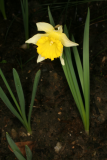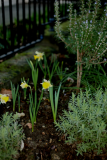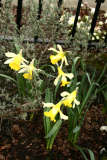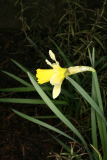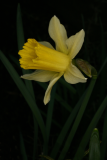Additional notes (click to expand)
Horticulture
Very, variable, small cupped daffodil with erect, strap-shaped, usually glaucous, mid-green leaves, 8-50cm (3-20in) long. Nodding flowers, 4-7cm across with yellow trumpets and narrow, twisted cream perianth segments, are produced in early spring. Good for naturalising. 15- 35cm high.
Brickell, C. (2003). A-Z Encyclopedia of Garden Plants. Dorling Kindersley. p.713
Plant bulbs at one and a half times their own depth in autumn, slightly deeper in light soils and in grass. Sow seed as soon as ripe in deep containers in a cold frame. After germination, keep frost free, cool, and moist. After 2 years, transfer seedlings to a nursery bed and grow on until they reach flowering size, which may take up to 7 years. Alternatively, separate and replant offsets as leaves fade in early summer, or in early autumn before new roots are produced.
The most serious pests and diseases include large narcissus bulb fly, narcissus eelworm, slugs, narcissus basal rot and other fungal infections, viruses, and bulb scale mite on bulbs forced for early flowering.
Brickell, C. (2003). A-Z Encyclopedia of Garden Plants. Dorling Kindersley. p.709
Medicinal
Galanthus nivalis and spp. and Narcissus pseudonarcissus contain galantamine. Galantamine is used for early Alzheimers as it is an acetylcholinesterase inhibitor. The brain cells concerned with memory communicate by a chemical called acetylcholine.
There is less acetylcholine in the brains of Alzheimer’s patients. Acetylcholine is broken down and recycled by the enzyme acetylcholinesterase. Acetylchoinesterase inhibitors stop its breakdown so acetylcholine levels in the brain increase. It does not really make much difference as dead brain cells cannot be made to work.
Oakeley, Dr. H.F. (2013). Real Medicinal Plants.
POM Acetylcholinesterase inhibitors
Nomenclature
Narci'sus- classical Greek name in honour of a beautiful youth who became so entranced with his own reflection that he pined away and the gods turned him into this flower. The word is possibly derived from an ancient Iranian language.
Stearn, W.T. (1996). Dictionary of Plant Names for Gardeners. Cassell. p.215
Other use
Our English wild daffodil had many names in the past, including Lent lily, bastard narcissus, yellow crowbels, narcissus lute and Pseudonarcissus. It is found throughout Western Europe. All parts of the plant are poisonous, especially the bulbs, although Lyte thought that the root boiled in water with a little anise or fennel seed and ginger cured coughs. Dangerously, online herbals still recommend it for bronchitis in children. In the long evolution of mankind by natural selection, those of our ancestors who had delicate stomachs vomited before a poison was digested and absorbed into the body. Those who could ‘eat anything’ died out. Dioscorides, writing on Narcissus poeticus, wrote that the bulbs made one vomit if eaten (a clear sign that they are poisonous), but they were good for healing wounds and ulcers if plastered on. Johnson, adding to Dodoens’ text, writes that the ‘distilled water of daffodils’ will cure someone of a stroke (‘palsy’) if the patient is bathed with it and has it rubbed on, beside a fire. As a measure of global warming, the daffodil now flowers two months earlier than it did a century ago.
Oakeley, Dr. Henry. (2011). A Year in the Medicinal Garden of the Royal College of Physicians, revised edition. Royal College of Physicians, London.
link
Toxicity
Notes: All parts of the plant are poisonous, especially the bulbs, so Culpeper was right to omit it. The on-line herbal medicine site http://www.holisticonline.com/ does not include it, although it is listed as both poisonous and having medicinal use in http://www.pfaf.org, where (dangerously) they advise it for bronchitis in children.
Plants for a Future (2014) (http://www.pfaf.org/)
"Humans/pets: Harmful if eaten; skin irritant."- HTA guidelines
The Horticultural Trades Association Guide to Potentially Harmful Plants 2022 https://hta.org.uk/poisonousplants
Geographical distribution
- Africa, Macaronesia, Madeira
- Asia-Temperate, Caucasus, Transcaucasus
- Europe, Middle Europe, Germany
- Europe, Middle Europe, Netherlands
- Europe, Middle Europe, Switzerland
- Europe, Northern Europe, Great Britain
- Europe, Southeastern Europe, Italy
- Europe, Southwestern Europe, France
- Europe, Southwestern Europe, Portugal
- Europe, Southwestern Europe, Spain
Podcast
Narcissus pseudonarcissus L.
Family: AMARYLLIDACEAEGenus: Narcissus
Species: pseudonarcissus L.
Common names: Wild Daffodil, Lent Lily
Pharmacopoeia Londinensis name: Narcissi
Distribution summary: Europe, Madeira Islands, Azerbaijan
Conservation status (IUCN Red List): Least Concern
Habit: Bulbous
Hardiness: H6 - Hardy; very cold winter
Habitat: Woods, banks, ditches, mountains
Garden status: Currently grown
Garden location: Pharmacopoeia Londinensis 1618 'Flowers' (HSE 1B), Pharmacopoeia Londinensis 1618 'Flowers' (HSE 1)
Flowering months: March
Reason for growing: Medicinal, toxic, prescription only medicine

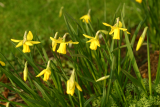
.JPG)
.jpg)
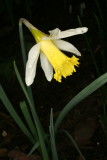
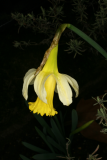
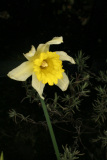
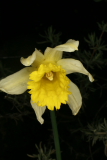
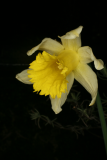
.JPG)
